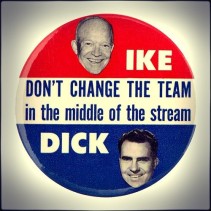By Christine Strangie–1828 & The Coffin Handbill
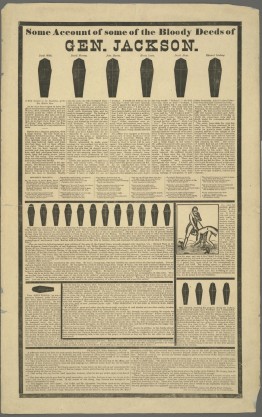 Mudslinging—the use of insults and accusations, especially unjust ones, with the aim of damaging the reputation of an opponent (Google). In 2017, mudslinging can be seen in campaign attack ads where the concept of image intersects with ideology and/or issues. In 1828 however, there was no cable television to help visualize the horrible qualities about the opposing characters. Instead, there was use of language, text and drawings to directly insult the candidate on issues, ideology, character, etc. Specifically, in the 1828 presidential election, Andrew Jackson, a Democrat was campaigning against John Quincy Adams, the incumbent of the National Republican party. Both candidates’ campaigns initially began with the concept of mudslinging and brought to life a whole new method of campaign rhetoric. Jackson accused Adams of misusing public funds for personal use, such as gambling devices for his residency. Adams accused Jackson more personally by attacking his wife Rachel and accusing her of not being officially divorced, and being an adulteress. However, one piece of rhetoric from this campaign that stuck out was the Coffin Handbill.
Mudslinging—the use of insults and accusations, especially unjust ones, with the aim of damaging the reputation of an opponent (Google). In 2017, mudslinging can be seen in campaign attack ads where the concept of image intersects with ideology and/or issues. In 1828 however, there was no cable television to help visualize the horrible qualities about the opposing characters. Instead, there was use of language, text and drawings to directly insult the candidate on issues, ideology, character, etc. Specifically, in the 1828 presidential election, Andrew Jackson, a Democrat was campaigning against John Quincy Adams, the incumbent of the National Republican party. Both candidates’ campaigns initially began with the concept of mudslinging and brought to life a whole new method of campaign rhetoric. Jackson accused Adams of misusing public funds for personal use, such as gambling devices for his residency. Adams accused Jackson more personally by attacking his wife Rachel and accusing her of not being officially divorced, and being an adulteress. However, one piece of rhetoric from this campaign that stuck out was the Coffin Handbill.
The Coffin Handbill was a series of pamphlets written by a Philadelphia editor, John Binns. The pamphlets aimed to directly attack General Jackson by humanizing the people he killed in battle, as well as describing him as a bloodthirsty murderer. The pamphlet is titled “Some Account of some of the Bloody Deeds of Andrew Jackson.” Visually, there are 23 coffins depicted to represent all that were murdered. The word ‘some’ holds a lot of weight in relation to the number of coffins because it makes Jackson look as if he is a serial killer. Although it is assumed that Jackson killed hundreds in the battle against Great Britain, the visual of the coffins as well as the names and stories beneath the coffins give life, as well as a face/story, to all that were killed. Binns aimed to simulate dialogue regarding the quantity of innocent individuals being murdered, as well as question the stability and civility of Andrew Jackson. The rhetorical theme of Jackson being a murderer or criminal made him seem unjust for a role such as the President of the United States.
When reading through the pamphlet, there were two stories and a quotation that stood out as important pieces of rhetoric. The first deals with the murder of a Native American woman and her three children. The story helps display the innocence of the victims and paints Jackson to look like a monster. As seen in history, and continuing now, women and children are supposed to be innocent, dainty and in need of protection. For Jackson to murder these four individuals who are supposed to be weak and presumably innocent, he looks careless and unstoppable. The story goes on to explain how Jackson invaded the tribe’s territory and completely destroyed their wellbeing as a community. Although invasions seemed common at this time, the lack of humanity and remorse in killing a mother and her children challenges Jackson’s ethics and morality. The indifference depicted throughout this specific story invites the reader to assume he would be aggressive in war tactics and be willing to attack anyone/anything. This type of rhetoric could easily evoke fear in potential voters, as well as disrupt their image of him as a war hero. Instead, they may have considered him a “cold-blooded murderer” and unfit to serve as president.
The second story that poses as an important piece of rhetoric is the visual of Jackson stabbing a man that is bent over. Although controversial and there being variations, Binns shared the story of a quarrel between Samuel and Andrew Jackson turning violent. After a heated argument turned violent, as you can see with both men’s top hats off of their heads, Samuel bent down to get a rock to defend himself. This is the moment Jackson stabbed him with his “sword cane,” when he least expected it. The story vividly describes the sword entering his “back and coming out his breast.” The gruesome details once again dehumanize Jackson, and make it appear that he was violent toward someone innocent and unknowing. Jackson was later charged with assault and battery based on this account, and once again it paints him to be a criminal and unfit to be president. The actual drawing depicting Jackson stabbing Samuel also poses some important rhetoric. Jackson almost appears to be wearing a Halloween mask based on the harsh wrinkles and anger drawn on his face. His vicious expression in comparison to Samuel being bent over disheveled and searching for a rock makes Jackson seem merciless and villainous. Although not related, Jackson did personally know Samuel and it shows how his anger could lead him to act violently and without care. Jackson appears to be relentless toward all individuals including ones he knew and had relationships with, which creates yet another concern for the American voter.
Finally, the quotation that follows the story of Samuel and Andrew Jackson poses as an important piece of rhetoric. Binns states, “gentle reader, it is for you to say, whether this man, who carries a sword cane and is willing to run it through the body of anyone who may presume to stand in his way, is fit to be president.” This statement almost reads like a rhetorical question—after posing all of these stories about Jackson being a murderer, being relentless and having no remorse, is he truly fit for presidency? Although the answer to Binns’ statement may seem obvious, he gives the power back to the reader and allows them to be the jury. The use of the word “gentle” weighs heavy in this sentence because it also makes the reader seem innocent and weak, and with the theme of this handbill assuming that Jackson would attack anyone, they would not be safe with him as president either. Additionally, Binns continues on the theme of attacking the weak and innocent by adding that he would “run it through the body of anyone who may presume to stand in his way”. The lack of civility described here are just examples of how Jackson could not possibly be the candidate for such a prestigious and noble position.
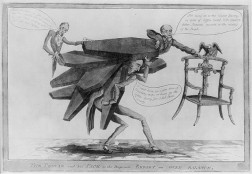 Although not the most successful piece of campaign rhetoric, the Coffin Handbill has served as an example for mudslinging for over a century. The irony of this piece of rhetoric and its lack of success came full circle with a political cartoon of Binns, Adams and the third party candidate, Henry Clay. The political cartoon shows John Binns holding the coffins of John Quincy Adams and Henry Clay, as they are both trying to claw their way out. Adams desperately is trying to hold onto the presidential reign, depicted as a fancy chair, and although his efforts were grand, he lost the presidential election that year. In the Coffin Handbill, John Binns allowed the people to decide whether or not they found Andrew Jackson guilty and unfit to serve as president. The jury is out, and they found General Andrew Jackson not guilty, and capable of being the 7th president of the United States.
Although not the most successful piece of campaign rhetoric, the Coffin Handbill has served as an example for mudslinging for over a century. The irony of this piece of rhetoric and its lack of success came full circle with a political cartoon of Binns, Adams and the third party candidate, Henry Clay. The political cartoon shows John Binns holding the coffins of John Quincy Adams and Henry Clay, as they are both trying to claw their way out. Adams desperately is trying to hold onto the presidential reign, depicted as a fancy chair, and although his efforts were grand, he lost the presidential election that year. In the Coffin Handbill, John Binns allowed the people to decide whether or not they found Andrew Jackson guilty and unfit to serve as president. The jury is out, and they found General Andrew Jackson not guilty, and capable of being the 7th president of the United States.
Sources:
Onion, Rebecca. “The “Coffin Handbill” Andrew Jackson’s Enemies Used to Circulate Word of His “Bloody Deeds”. Slate Magazine. The Vault, 05 Mar. 2014. Web. 09 May 2017.
“Presidential Campaigns: A Cartoon History 1789-1976.” Indiana University. Indiana University, 2008. Web. 09 May 2017.
By Carrie Zambrano–Relating to the People, 1992
The 1992 election was notable for several reasons. First, the incumbent president, George H.W. Bush was running for re-election. Most presidents in his position face little opposition. But Bush received push back from some of his fellow conservatives after he famously pledged not to raise taxes in a speech he made during his first campaign in 1988. In addition, the economy was in a recession and his strength in foreign policy became less important due to the end of the Cold War and the defeat of Iraq in the Gulf War. Secondly, the third part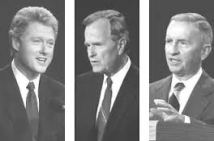 y candidate, Ross Perot was a leading candidate. He self-funded his own campaign and ran as a one-issue candidate, focusing on the deficit. Although he was popular, he lost momentum after he dropped out and then eventually re-entered the race. Ultimately, Perot garnered 19% of the vote, which was uncommon for a third party candidate. Lastly, Bill Clinton, the Democratic nominee, won the election, ending twelve years of Republican control. This was the third time in the twentieth century that a sitting president did not get re-elected. Clinton ran his campaign with a new Democratic ideology which allowed him to relate to a wide range of people. Clinton’s ability to relate to the American people is what ultimately won him the presidency.
y candidate, Ross Perot was a leading candidate. He self-funded his own campaign and ran as a one-issue candidate, focusing on the deficit. Although he was popular, he lost momentum after he dropped out and then eventually re-entered the race. Ultimately, Perot garnered 19% of the vote, which was uncommon for a third party candidate. Lastly, Bill Clinton, the Democratic nominee, won the election, ending twelve years of Republican control. This was the third time in the twentieth century that a sitting president did not get re-elected. Clinton ran his campaign with a new Democratic ideology which allowed him to relate to a wide range of people. Clinton’s ability to relate to the American people is what ultimately won him the presidency.
The ability for a presidential candidate to relate to the citizens of the United States has always been crucial in order to gain votes. During the 1992 election, this was one of the key differences that separated Bush and Clinton. And throughout the campaign we see several rhetorical examples in which this difference is displayed. One of the most notable rhetorical examples of this can be seen towards the end of the second town hall debate. During this debate, a woman stood up and asked the candidates, “How has the national debt personally affected you?” Bush answered first, giving a very unrelatable response, stating that, “I’m sure it has.” He went on to say how as president he has seen people struggle and that he wants to help  by stimulating the economy but avoided answering until the woman asked the question again. Bush then responded saying how “it’s not fair to say you can’t be affected because you haven’t been hit personally.” This statement shows that he is practically admitting to the fact that he does not know exactly how it is like to be affected by the economy. In addition, his tone seemed defensive and insensitive. Clinton responded to the question second. Immediately, the tone is different. He appears to be more caring and concerned. Although he, too, did not directly address how he was personally affected, the quality of this response made him more relatable. He finished by saying, “we need to bring the American people together.”
by stimulating the economy but avoided answering until the woman asked the question again. Bush then responded saying how “it’s not fair to say you can’t be affected because you haven’t been hit personally.” This statement shows that he is practically admitting to the fact that he does not know exactly how it is like to be affected by the economy. In addition, his tone seemed defensive and insensitive. Clinton responded to the question second. Immediately, the tone is different. He appears to be more caring and concerned. Although he, too, did not directly address how he was personally affected, the quality of this response made him more relatable. He finished by saying, “we need to bring the American people together.”
Another notable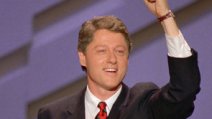 rhetorical moment is Bill Clinton’s acceptance speech at the Democratic National Convention. This speech further exemplifies Clinton’s desire to want to relate to the American people and bring everyone together. His fifty three minute speech is filled with messages of hope, change, and unity. He begins by accepting the nomination on behalf of “all those who do the work, pay the taxes, raise the kids and play by the rules — in the name of the hard-working Americans who make up our forgotten middle class.” He goes on to say, “I am a product of the middle class and when I am president you will be forgotten no more.” These words allow him to really relate to a majority of Americans on an economic level. Clinton then moves on to salute the collapse of the Soviet Union and the official end to the Cold War. He wants to see the success America has accomplished abroad, at home. He says, “Now that we have changed the world, it’s time to change America”. He continues to try and relate to the people on a personal level by sharing emotional stories of his mother and father and how he grew up in Hope, Arkansas. He makes a particular well known statement in regards to his mother, “You want to know where I get my fighting spirit? It all started with my mother. Thank you, Mother. I love you,“ Clinton said. Clinton had been vocal about women’s equality in the workplace and in regards to health care and his statement showed where his stance on women’s issues originated. One of the final most notable parts of the speech is when Clinton is discussing the current government. He says, “Frankly, I’m fed up with politicians in Washington lecturing the rest of us about family values. Our families have values but our government doesn’t.” Clinton is tired of the current system and wants to see a change. His comments sparked applause from the audience, who were agreeing with his messages. Ultimately, Clinton wanted to let people know that he is serious about change and that he wants to focus on the economy and other issues that were not addressed in the previous administration.
rhetorical moment is Bill Clinton’s acceptance speech at the Democratic National Convention. This speech further exemplifies Clinton’s desire to want to relate to the American people and bring everyone together. His fifty three minute speech is filled with messages of hope, change, and unity. He begins by accepting the nomination on behalf of “all those who do the work, pay the taxes, raise the kids and play by the rules — in the name of the hard-working Americans who make up our forgotten middle class.” He goes on to say, “I am a product of the middle class and when I am president you will be forgotten no more.” These words allow him to really relate to a majority of Americans on an economic level. Clinton then moves on to salute the collapse of the Soviet Union and the official end to the Cold War. He wants to see the success America has accomplished abroad, at home. He says, “Now that we have changed the world, it’s time to change America”. He continues to try and relate to the people on a personal level by sharing emotional stories of his mother and father and how he grew up in Hope, Arkansas. He makes a particular well known statement in regards to his mother, “You want to know where I get my fighting spirit? It all started with my mother. Thank you, Mother. I love you,“ Clinton said. Clinton had been vocal about women’s equality in the workplace and in regards to health care and his statement showed where his stance on women’s issues originated. One of the final most notable parts of the speech is when Clinton is discussing the current government. He says, “Frankly, I’m fed up with politicians in Washington lecturing the rest of us about family values. Our families have values but our government doesn’t.” Clinton is tired of the current system and wants to see a change. His comments sparked applause from the audience, who were agreeing with his messages. Ultimately, Clinton wanted to let people know that he is serious about change and that he wants to focus on the economy and other issues that were not addressed in the previous administration.
References
“1992 Presidential Election.” 1992 Presidential Election – Timeline – Slaying the Dragon of Debt – Regional Oral History Office – University of California, Berkeley. N.p., n.d. Web. 09 May 2017.
Levy, Michael. “United States Presidential Election of 1992.” Encyclopædia Britannica. Encyclopædia Britannica, Inc., n.d. Web. 09 May 2017.
“Transcript of Speech by Clinton Accepting Democratic Nomination.” The New York Times, 16 July 1992. Web. 09 May 2017.
Toner, Robin. “CLINTON CAPTURES PRESIDENCY WITH HUGE ELECTORAL MARGIN; WINS A DEMOCRATIC CONGRESS.” The New York Times, 03 Nov. 1992. Web. 09 May 2017.
By Joey Williams–2008 Presidential Election
The presidential election of 2008 was a historic election for the United States. While then-senator Barack Obama became the first African American to be elected as president of the United States, Joe Biden represented the first Roman Catholic to hold the office of Vice President. To get there, Obama first defeated Hillary Clinton in one of the most tightly contested primary elections in history. Although Clinton was long considered the frontrunner for the race, Obama won Iowa and gained momentum from there. After losing Iowa, the Clinton team was unprepared to recover and Oba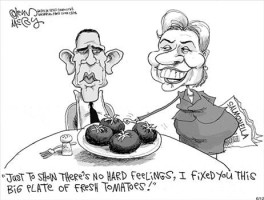 ma continued to upset her in key elections. In June, after Obama secured the nomination to end a close race, Clinton delayed conceding the race by multiple days even though it was clear she knew it was over. When she finally conceded on June 7, 2008, she pledged her full support toward Obama, and would later accept a position as his Secretary of State. Although she lost the election, Clinton made history as the first woman in U.S. history to win a major political party primary election by winning the New Hampshire primary.
ma continued to upset her in key elections. In June, after Obama secured the nomination to end a close race, Clinton delayed conceding the race by multiple days even though it was clear she knew it was over. When she finally conceded on June 7, 2008, she pledged her full support toward Obama, and would later accept a position as his Secretary of State. Although she lost the election, Clinton made history as the first woman in U.S. history to win a major political party primary election by winning the New Hampshire primary.
Upon winning the primary, Obama matched up against Senator John McCain in the general election. To match the historical ticket of Obama and Biden, McCain nominated Sarah Palin as his candidate for Vice President. Palin, the first woman ever on a Republican presidential ballot, had political experience as the Governor of Alaska from 2006-2009. Palin quickly grew a reputation of being dim-witted and unfit for office. Additionally, due to McCain’s age, many people complained about the possibility of Palin replacing him in office. Largely due to the historical implications of the election, voter turnout increased from previous elections. The demographic splits reflected the 25-year age difference between the two candidates, with Obama getting a significant majority of young voters and McCain getting the elderly vote. In a decisive victory, Obama received 365 electoral votes compared to McCain’s 173.
In the years leading up to the election, the United States waged a divisive war in Iraq. So, of course, during the 2008 election cycle, the war was one of the top issues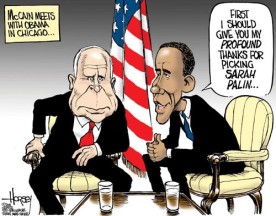 that the candidates debated. John McCain supported the war from the beginning and continued to assert it was an important war. Obama, on the other hand, rejected the war from the beginning and maintained that there should be a timetable for the removal of all troops. This was a fair representation of the rhetorical strategies of the two candidates. John McCain’s campaign had a central theme of “fight” and “experience.” As he said in one of his TV ads, “one man does what’s best for America, not what’s easy.” Additionally, in response to the high likeability that Barack Obama had, McCain stated, “I didn’t go to Washington to win Mr. Congeniality, I went there to serve my country.” McCain’s main slogan was “country first.” Obama, on the other hand, took a more radical approach, using “Change” and “Yes We Can” as his main slogans.
that the candidates debated. John McCain supported the war from the beginning and continued to assert it was an important war. Obama, on the other hand, rejected the war from the beginning and maintained that there should be a timetable for the removal of all troops. This was a fair representation of the rhetorical strategies of the two candidates. John McCain’s campaign had a central theme of “fight” and “experience.” As he said in one of his TV ads, “one man does what’s best for America, not what’s easy.” Additionally, in response to the high likeability that Barack Obama had, McCain stated, “I didn’t go to Washington to win Mr. Congeniality, I went there to serve my country.” McCain’s main slogan was “country first.” Obama, on the other hand, took a more radical approach, using “Change” and “Yes We Can” as his main slogans.
Due to the economic recession of 2008, Obama’s “change” slogan was a very important part of his campaign. Many people were in difficult living situations due to the high unemployment levels, and a man who preaches drastic change was exactly the right person to garner national support. Additionally, Obama became known for his unwavering positivity about our country’s future. At a time when things seemed bleak for so many, maintaining a positive image of America allowed Obama to win over many undecided voters. Because of Obama maintained such a positive and likeable public persona, McCain took to regularly questioning his record VS. rhetoric. “He’s not willing to drill for energy, but he’s sure willing to drill for votes,” Sarah Palin exclaimed to a group of supporters in Pennsylvania. In the same speech, she referred to Obama as “a guy who’s just tried to talk his way into the White House.”
In addition to the economic and national security issues of the time, race played a large role in the election of 2008. Although Obama was the first African American nominated by a major U.S. party, he restrained from play ing the race card throughout the election. This was mainly met with respect by the American people. Of course, to many racists in the country, an African American being an election away from holding the highest office in the country was very threatening. At many McCain rallies, racist chants were hurled toward the stage in support of the white candidate. While this was going on, McCain initially took the respectable approach of condemning racist supporters. In one incident, one woman told McCain at a rally that she was afraid of Obama because he is “an Arab.” Senator McCain, taking the high road, repeatedly shook his head and replied “no ma’am. He’s a decent, family man citizen, that I just happen to have disagreements with on fundamental issues and that’s what this campaign is all about.” While he took this approach early, McCain fell off a little bit as he fell behind in the race. As Obama pulled ahead, McCain backed off from silencing his racist supporters.
ing the race card throughout the election. This was mainly met with respect by the American people. Of course, to many racists in the country, an African American being an election away from holding the highest office in the country was very threatening. At many McCain rallies, racist chants were hurled toward the stage in support of the white candidate. While this was going on, McCain initially took the respectable approach of condemning racist supporters. In one incident, one woman told McCain at a rally that she was afraid of Obama because he is “an Arab.” Senator McCain, taking the high road, repeatedly shook his head and replied “no ma’am. He’s a decent, family man citizen, that I just happen to have disagreements with on fundamental issues and that’s what this campaign is all about.” While he took this approach early, McCain fell off a little bit as he fell behind in the race. As Obama pulled ahead, McCain backed off from silencing his racist supporters.
Ultimately, Barack Obama entered the 2008 election prepared for the racial attacks he would get. Like Hillary Clinton’s gender in 2016, Obama knew that his race would play a role in how he was perceived. Instead of crumbling under the unfair expectation, Obama confidently and calmly carried himself to victory. While John McCain did not make any major mistakes, America wanted change and Barack Obama seemed to live and breathe it.
References:
- http://www.npr.org/templates/story/story.php?storyId=18437398
- https://www.icpsr.umich.edu/icpsrweb/instructors/setups2008/campaign-issues.jsp
- http://steph-a-nee-rvsd.blogspot.com/2008/12/current-event-political-cartoon.html
- http://www.cbsnews.com/news/mccain-hits-obama-on-record-vs-rhetoric/
- https://www.youtube.com/watch?v=jrnRU3ocIH4
- http://www.nytimes.com/2008/10/12/opinion/12rich.html
- http://media.cagle.com/73/2008/10/13/56484_600.jpg
By Taylor Eitelberg–Ike Re-elected, 1956
The 1956 presidential race was a re-match from 1952, as Republican President Dwight D. Eisenhower successfully defeated Adlai Stevenson for the second time.
Eisenhower utilized simple tactics and produced a campaign that was very straightforward. In some ways it seemed that Eisenhower already knew or assumed he would be victorious. The Republican’s television ads played on the fact that Stevenson didn’t have extensive experience in the army, which was a fact that Americans were already informed about. One commercial delivers a passive remark to the public stating “are you willing to bet everything you love and hold dear on Stevenson, are you sure of it? four years ago you did something about it, you registered and you voted Eisenhower into office… so make the right choice again.”
Eisenhower decided to promote his success with the Korean War and ensure the Americans understood he was the reason we remained out of conflict. The majority of Eisenhower’s public support was caused by the way he maneuvered the two foreign-policy crises that occurred in the Soviet Union and his forceful removal of western forces from Egypt. Overall, Eisenhower’s first four years within the White House were a major success, so his second win was almost inevitable. Even Stevenson agreed with this sentiment, as demonstrated by his 1964 interview with the New Yorker.
Both times I ran it was obviously hopeless. To run as a Democrat in 1952 was hopeless, let alone run against the No.1 War Hero.
BUT there was a catch. The popular and well-liked President Eisenhower was in another battle, a battle of life and death. Adlai Stevenson campaigned vigorously and utilized his opponent’s sickness to promote his own campaign. Stevenson rarely criticized against substantive issues and tended to be vague and ambiguous. So, his criticism of Eisenhower’s sickness came as a bit of a shock… and definitely did nothing to aid his campaign. Stevenson was attempting to dominate the election by convincing the public to believe that Eisenhower wouldn’t live through his next term as president. Then, if Eisenhower died the person who would take over would be his controversial running mate, Vice-President Richard Nixon.
I must say bluntly that every piece of scientific evidence we have, every lesson of history and experience, indicates that a Republican victory tomorrow would mean that Richard M. Nixon would probably be President of this country within the next four years.
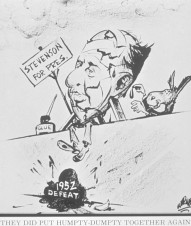 However, Stevenson’s decisive ploys failed, which could also be credited to his public disapproval of the recent changes within segregation. In 1954, during Eisenhower’s first-term, the Supreme Court ruled in the case Brown vs. Board of Education against state-mandated segregation in public education. This was a major turning point in history; while the Eisenhower administration supported the 1954 ruling, Stevenson voiced his inherent disapproval. According to Stevenson, Americans “don’t need reforms or grouping experiments” and believed the U.S. was wrong to “upset the habits and traditions that are older than the Republic” (Klarman.) Stevenson didn’t prepare for his comments to create a public controversy, but his demeanor proved an aid to his political demise.
However, Stevenson’s decisive ploys failed, which could also be credited to his public disapproval of the recent changes within segregation. In 1954, during Eisenhower’s first-term, the Supreme Court ruled in the case Brown vs. Board of Education against state-mandated segregation in public education. This was a major turning point in history; while the Eisenhower administration supported the 1954 ruling, Stevenson voiced his inherent disapproval. According to Stevenson, Americans “don’t need reforms or grouping experiments” and believed the U.S. was wrong to “upset the habits and traditions that are older than the Republic” (Klarman.) Stevenson didn’t prepare for his comments to create a public controversy, but his demeanor proved an aid to his political demise.
References:
Epstein, J., Gordon, J. S., Soloveichik, M. Y., Rothman, N., Meisel, E. C., Ferguson, A., . . .Teachout, T. (2017, April 27). Adlai Stevenson in Retrospect. Retrieved May 09, 2017, from https://www.commentarymagazine.com/articles/adlai-stevenson-in-retrospect/
Klarman, Michael J., Brown V. Board Of Education And The Civil Rights Movement. 1st ed. Oxford: Oxford University Press, 2007.
Mickey, R. (2015). PROLOGUE TO PART THREE: “No Solution Offers Except Coercion” Brown, Massive resistance, and Campus Crises, 1950–63. In Paths Out of Dixie: The Democratization of Authoritarian Enclaves in America’s Deep South, 1944-1972: The Democratization of Authoritarian Enclaves in America’s Deep South, 1944-1972 (pp. 173-189). Princeton University Press. Retrieved from http://www.jstor.org/stable/j.ctt7t1q8.10.
By Hannah Richardson–“Are You Better Off than You Were Four Years Ago?”–1980
The election of 1980 was a landslide win for the Republican candidate, Ronald Reagan. He ran against the Democratic incumbent president, Jimmy Carter, an Independent Illinois Congressman, John B. Anderson, and Libertarian candidate, Ed Clark. Ronald Reagan was the former Governor of California. He also had a successful career as an actor in Hollywood. President Carter was elected in 1977 as the 39th President of the United States. Prior to becoming President, Carter served as the Governor of Georgia and was a member of the Georgia Senate. John B. Anderson had enough popularity that he was considered a solid candidate but ended up receiving no electoral votes and 6.6% of the popular vote. There were several factors that influenced the outcome of the 1980 election but one critical moment was the Presidential debate of 1980 between Governor Reagan and President Carter. This debate coupled with the optimism of Reagan’s campaign and the attacks from Carter’s campaign are major factors that influenced the outcome of the election.
The debates for this election cycle had a rocky start. For the first debate, the League of Women Voters announced that Rep. Anderson would join Governor Reagan and President Carter on stage. Carter refused to participate with Rep. Anderson included and Reagan refused to debate without him. After several negotiations, the League of Women Voters put together a debate that was held on Septem ber 21, 1980 in the Baltimore Convention Center. The debate covered several issues and polls after the debate indicated that Governor Reagan had won the debate. In this debate Reagan used the phrase, “there you go again,” in response to an attack Carter was making against him. This had a surprisingly big impact on the debate. Governor Reagan used this phrase to disarm Carter and threw him off his offense. The line became very popular and was used in newspaper headlines and news broadcasts. Another major sound bite from the debate was when Governor Reagan asked, “Are you better off than you were four years ago?” In the debate, he said:
ber 21, 1980 in the Baltimore Convention Center. The debate covered several issues and polls after the debate indicated that Governor Reagan had won the debate. In this debate Reagan used the phrase, “there you go again,” in response to an attack Carter was making against him. This had a surprisingly big impact on the debate. Governor Reagan used this phrase to disarm Carter and threw him off his offense. The line became very popular and was used in newspaper headlines and news broadcasts. Another major sound bite from the debate was when Governor Reagan asked, “Are you better off than you were four years ago?” In the debate, he said:
Next Tuesday all of you will go to the polls, will stand there in the polling place and make a decision. I think when you make that decision, it might be well if you would ask yourself, are you better off than you were four years ago? Is it easier for you to go and buy things in the stores than it was four years ago? Is there more or less unemployment in the country than there was four years ago? Is America as respected throughout the world as it was? Do you feel that our security is as safe, that we’re as strong as we were four years ago?
This idea was a major theme of Reagan’s campaign and was even used as a campaign slogan. Governor Reagan argued that the Carter Administration had not been successful and that he would bring change. The debate was just a week before the election and Governor Reagan’s statement was a final blow against President Carter. Both candidates heavily focused on the image of the last four years. President Carter spent a great deal of time trying to convince the American people that his last four years had been successful whereas Governor Reagan tried to show the downfalls of the current administration. This is largely shown through each candidate’s television advertisements.
President Carter worked hard to try to show that his time in office had been successful and that he deserved to stay. He put out advertisements showing things he had accomplished but also spent a lot of time attacking Governor Reagan. One example of his attempt to diminish Governor Reagan was his advertisement, “Streetgov,” where the campaign interviewed citizens of California who all said they were not happy with Reagan as a leader. President Carter received a lot of backlash for running a campaign that was so focused on attacking his opponent. Many people believed this was a tactic of President Carter’s. By drawing attention to his attacks on Governor Reagan he was taking attention away from the diminishing economy. A cartoonist named Jeff MacNelly depicted this in a cartoon that was published in October of 1980 in the Chicago Tribune. He depicts Carter driving a train that has clearly crashed and is labeled “Economy.” He is the 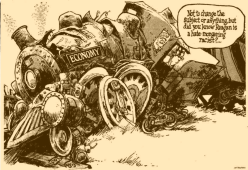 driver and he is saying “Not to change the subject or anything but did you know Reagan is a hate-mongering racist?” President Carter’s attacks became a major focus in the election. To refute the attacks, the Reagan Campaign did something new. They had Nancy Reagan, Ronald Reagan’s wife, narrate an advertisement refuting the attacks that President Carter made against Governor Reagan. It was an attack ad made to look like a spouse defending her husband. The advertisement stuck to the theme that was to show the people that President Carter had not been a good president and that Governor Reagan would bring change and optimism. This strategic move worked in Governor Reagan’s favor. It did both, validate the American people who thought Carter’s campaign was being overly attacking and promote the idea that change was needed.
driver and he is saying “Not to change the subject or anything but did you know Reagan is a hate-mongering racist?” President Carter’s attacks became a major focus in the election. To refute the attacks, the Reagan Campaign did something new. They had Nancy Reagan, Ronald Reagan’s wife, narrate an advertisement refuting the attacks that President Carter made against Governor Reagan. It was an attack ad made to look like a spouse defending her husband. The advertisement stuck to the theme that was to show the people that President Carter had not been a good president and that Governor Reagan would bring change and optimism. This strategic move worked in Governor Reagan’s favor. It did both, validate the American people who thought Carter’s campaign was being overly attacking and promote the idea that change was needed.
The election was held on November 4, 1980, where Ronald Reagan was elected president receiving 489 electoral votes and 50.7% of the popular vote. For the first time since 1952, Republicans had gained control of the Senate. There were several additional issues that impacted the election, including the Iranian hostage crisis. The Iran hostage crisis loomed over President Carter’s chances of reelection. In November 1979, 50 Americans were taken hostage at the U.S. Embassy in Tehran. For the year leading up to the election, President Carter was seen as unable to solve the problem and get the hostages safely released. This was a major issues that Governor Reagan worked with to help discredit his opponent . The hostages were released on January 21, 1981, after President Reagan delivered his inaugural address. Reagan was able to make Carter appear weak between the presidential debate and his rebuttal against Carter’s attacks through his own advertisements. Though President Reagan won in a landslide it is important to note that there was a lot of scandal surrounding his candidacy. A major scandal that some argue could have had a big impact on the election was the fact that some of Governor Reagan’s aides had the notes for the 1980 debate from Carter’s campaign. Because the debate had such an impact on the election it can be argued that it could have won Reagan the election and had he not have had access to some of Carter’s notes he may not have done as well. Reagan’s win was assisted by the events surrounding the Iran Hostage Crisis and the worsening economy. President Reagan was credited with the release of the hostages and went on to serve a second term.
. The hostages were released on January 21, 1981, after President Reagan delivered his inaugural address. Reagan was able to make Carter appear weak between the presidential debate and his rebuttal against Carter’s attacks through his own advertisements. Though President Reagan won in a landslide it is important to note that there was a lot of scandal surrounding his candidacy. A major scandal that some argue could have had a big impact on the election was the fact that some of Governor Reagan’s aides had the notes for the 1980 debate from Carter’s campaign. Because the debate had such an impact on the election it can be argued that it could have won Reagan the election and had he not have had access to some of Carter’s notes he may not have done as well. Reagan’s win was assisted by the events surrounding the Iran Hostage Crisis and the worsening economy. President Reagan was credited with the release of the hostages and went on to serve a second term.
By Justin Hammond–Reelecting Lincoln, 1864
 The 1864 presidential election was distinctive because it took place during the American Civil War (the first presidential election to take place during a war since 1812), and involved one of the most famous figures of American history- the sitting president Abraham Lincoln. An incumbent candidate had not been elected for a second term since 1832. Lincoln’s opponent was George B. McClellan, a U.S. Army officer. McClellan ran on a peace platform of the Democratic party; while the Republicans formed the National Union Party. The National Union Party consisted of Republicans and War Democrats (Democrats who rejected the Peace Democrats’ policies). McClellan, representing the Peace Democrats, advocated putting the Civil War to a quick end, even if he did not necessarily agree with his party’s full platform.
The 1864 presidential election was distinctive because it took place during the American Civil War (the first presidential election to take place during a war since 1812), and involved one of the most famous figures of American history- the sitting president Abraham Lincoln. An incumbent candidate had not been elected for a second term since 1832. Lincoln’s opponent was George B. McClellan, a U.S. Army officer. McClellan ran on a peace platform of the Democratic party; while the Republicans formed the National Union Party. The National Union Party consisted of Republicans and War Democrats (Democrats who rejected the Peace Democrats’ policies). McClellan, representing the Peace Democrats, advocated putting the Civil War to a quick end, even if he did not necessarily agree with his party’s full platform.
One Democratic broadside (right) sums up the major differences between the two parties. The Democrats (or ‘Peace’ party) wanted a speedy end to the Civil War, and to end the notion of emancipation. The National Union Party (Republicans) wanted to pursue the war until the Confederacy completely surrendered. This election proved to ultimately determine the outcome of the Civil War, and the fate of the union.
This is a popula r political cartoon (left) from the 1864 campaign; it is by Currier & Ives and is titled: “The True Issue or ‘That’s What’s the Matter.’” This cartoon portrays George McClellan as the mediator between Abraham Lincoln and the president of the Confederacy, Jefferson Davis. Lincoln while grasping one side of the map is proclaiming “No peace without Abolition!” and Davis wielding the other side of the map as it tears is proclaiming “No peace without Separation!!” McClellan is portrayed as a go-between over the map of the United States. He holds the two men back and proclaims, “The Union must be preserved at all hazards!” This cartoon represents the Peace Democrats campaign, specifically illustrating the National Union Party’s mindset of wanting the war to continue. This cartoon is implying that if the war continues, it will “tear” the United States apart; McClellan acts as a “peace-maker” in the scenario, stopping the two sides from ripping the country apart.
r political cartoon (left) from the 1864 campaign; it is by Currier & Ives and is titled: “The True Issue or ‘That’s What’s the Matter.’” This cartoon portrays George McClellan as the mediator between Abraham Lincoln and the president of the Confederacy, Jefferson Davis. Lincoln while grasping one side of the map is proclaiming “No peace without Abolition!” and Davis wielding the other side of the map as it tears is proclaiming “No peace without Separation!!” McClellan is portrayed as a go-between over the map of the United States. He holds the two men back and proclaims, “The Union must be preserved at all hazards!” This cartoon represents the Peace Democrats campaign, specifically illustrating the National Union Party’s mindset of wanting the war to continue. This cartoon is implying that if the war continues, it will “tear” the United States apart; McClellan acts as a “peace-maker” in the scenario, stopping the two sides from ripping the country apart.
 This is another political cartoon (right) that circulated during the 1864 presidential campaign. This is from Harper’s Weekly, and portrays Abraham Lincoln with a miniature George McClellan with a tiny shovel in the palm of his hand, Lincoln is stating “this reminds me of a little joke.” In November of 1862, Lincoln relieved McClellan of his command after he showed reluctance in pursuing and defeating the Confederates. When the 1864 election rolled around, McClellan was slow to start campaigning following his nomination at the Democratic National Convention; Lincoln joked about this, comparing McClellan’s delays as like his delays in battle; this joke is the meaning behind this political cartoon.
This is another political cartoon (right) that circulated during the 1864 presidential campaign. This is from Harper’s Weekly, and portrays Abraham Lincoln with a miniature George McClellan with a tiny shovel in the palm of his hand, Lincoln is stating “this reminds me of a little joke.” In November of 1862, Lincoln relieved McClellan of his command after he showed reluctance in pursuing and defeating the Confederates. When the 1864 election rolled around, McClellan was slow to start campaigning following his nomination at the Democratic National Convention; Lincoln joked about this, comparing McClellan’s delays as like his delays in battle; this joke is the meaning behind this political cartoon.
The summer of 1864 was rough for the Union army, as they kept taking overwhelming defeats. The Union armies had a very hard time staggering the Southern forces, with two defeats in Virginia, and one in Georgia and Louisiana. Lincoln wrote a dour memorandum on August 23, 1864, asking his cabinet to accept the grim prospects for his re-election: “This morning, as for some days past, it seems exceedingly probable that this Administration will not be re-elected. Then it will be my duty to so cooperate with the President-elect as to save the Union between the election and the inauguration; as he will have secured his election on such grounds that he cannot possibly save it afterwards.” However, everything turned around for Lincoln and the Union when General William T. Sherman took Atlanta in September 1864. This remarkable military development, along with internal conflict within the Democratic Party, helped strengthen Lincoln’s chance at victory.
Although during the summer of 1864 the chances of Lincoln being re-elected looked very slim, he ended up defeating McClellan by a pretty significant margin. Lincoln won all but three states (Delaware, Kentucky, and New Jersey); more significantly, Lincoln won 212 electoral votes to McClellan’s 21.
In all, this was an election (and campaign) fully influenced by the American Civil War. This was the first presidential election that took place during a time with this severity of military tension within our country. Just five months after the re-election of Abraham Lincoln, though, the defeat of the Confederacy was accomplished.
References:
http://www.history.com/this-day-in-history/lincoln-reelected
By Hannah Richardson–“Know Nothing” Rhetoric, 1856
A third-party candidate has yet to become President but many third-party campaigns have had a major impact on Presidential elections. Perhaps one of the most influential third-party campaigns was that of former United States President, Millard Fillmore, from the American Party, in the election of 1856. The American Party, also known as the “Know Nothing” Party rallied behind the idea of nativism. They strongly opposed immigrants and Catholics and embraced working class values. The Know Nothing campaign was able to influence the election by embracing nativism and opposing Catholicism in their rhetoric.
The election of 1856 began on an interesting note with the Democrats not re-nominating the incumbent President, Franklin Pierce. Instead, the Democratic Party nominated former Secretary of State, James Buchanan. The fairly young Republican Party nominated former U.S. Senator John C. Frémont. The Republican Party was formed just a few years earlier in 1854 to oppose the Kansas-Nebraska Act. Slavery and its extension into new territories was a major issue during this time and was on the minds of all voters. The fractured nation was finding its way around several party divisions and creating new parties that represented the new interests in America. The popular Whig Party had split due to their varying stances on slavery and new parties such as the Free Soil Party, the North American Party, the North American Seceders Party and the Liberty Party were formed. Slavery played a very critical role in the rise of the Know Nothing Party and although the party failed in getting their candidate to the White House they were able to have an impact on this election. This election was one of the first years that a third-party candidate had a competitive role in the presidential election. The Know Nothings wanted to keep the rhetoric focused on nativism and found many ways to do so. The party began a crusade claiming that the Republican candidate, John C. Frémont was Catholic. This accusation was an important aspect of the election.
After rumors broke out the Frémont was secretly Catholic, the Know Nothings perpetuated the idea to get the campaign rhetoric focused on nativism. They argued that he was married in a Catholic church and sent his daughter to Catholic school and therefore must have been hiding his Catholicism. Many Americans had strong anti-Catholicism ideals at this time. They feared Catholicism would take over and the Pope would one day rule America. Frémont expressed that he was Episcopalian but the rumors still tarnished his name to those Americans who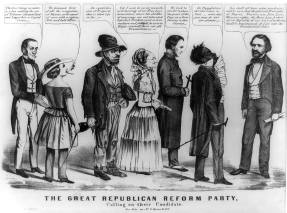 held strongly to the idea of nativism. In the cartoon called “The Great Republican Reform Party, Calling on their Candidate,” John Frémont is being targeted for being Catholic as well as supporting other radical social reform movements such as feminism, abolition, religious tolerance, and open marriage. The cartoon has several citizens that represent the various progressive reforms people feared from Frémont. They are all looking to him and he is looking right back at them telling them that they will get what he wants if he becomes president. His progressivism was deeply disturbing to Americans who believed nativism was important. Though this was not enough to focus the campaign dialogue on nativism it did have an impact on the country. One of the reasons the issue of Catholicism and immigration was not as influential as it may have been in other elections was because there was a much more pressing issue on the public’s mind which was slavery.
held strongly to the idea of nativism. In the cartoon called “The Great Republican Reform Party, Calling on their Candidate,” John Frémont is being targeted for being Catholic as well as supporting other radical social reform movements such as feminism, abolition, religious tolerance, and open marriage. The cartoon has several citizens that represent the various progressive reforms people feared from Frémont. They are all looking to him and he is looking right back at them telling them that they will get what he wants if he becomes president. His progressivism was deeply disturbing to Americans who believed nativism was important. Though this was not enough to focus the campaign dialogue on nativism it did have an impact on the country. One of the reasons the issue of Catholicism and immigration was not as influential as it may have been in other elections was because there was a much more pressing issue on the public’s mind which was slavery.
Political parties across the nation were divided over the issue of slavery in the 1850s. The passing of the Kansas-Nebraska Act played a major role in fragmenting the political parties and remained a major part of the discourse in 1856. The Republican Party strongly opposed slavery expansion and opposed the Kansas-Nebraska Act whereas the Democrats supported it. When the Republicans crusaded against slave power the Democrats warned that a Republican victory would bring on a civil war. One of the biggest downfalls to the Know Nothing Party was the fact they did not take a stance on slavery. Their platform focused on nativism and anti-immigration and said nothing of the issue of slavery in America. Since slavery was such an important issue at the time many people strayed away from voting for Fillmore and were forced to choose another party and many people did so solely on their views on slavery. The lack of rhetoric on slavery from the Know Nothing Party was damaging to the parties following.
The election of 1856 ended in a Democratic victory with James Buchanan becoming President and John Frémont in second place. Though Millard Fillmore only received 8 electoral votes he gained 21.6% of the popular vote- enough to sway the election. Though many Americans opposed the Catholic faith and immigration – slavery and its expansion was more important and the Know Nothing party refused to take a stand on slavery. In the election of 1856, the Know Nothing Party served as an instigator that took votes from the other parties and swayed votes away from the Re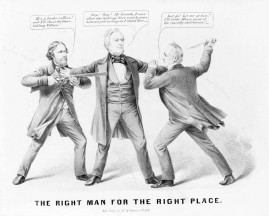 publicans. In the political cartoon called “The Right Man for the Right Place” Fillmore is ironically standing between the two other candidates demanding peace as we see Buchanan (right) associated with violence against antislavery settlers and Frémont (left) associated with anti-slavery sentiments but violently pointing a gun. The faces of Frémont and Buchanan look uneasy while Fillmore is standing strong in the middle with a determined face. Frémont and Buchanan are also angled toward each other while Fillmore is front and center facing out with open arms. Frémont has a gun while Buchanan has a knife suggesting that Buchanan would lose in the current situation. Both Buchanan and Frémont have speech bubbles that relate to slavery while Fillmore is just talking about having peace. This is a great representation of the Know Nothing Party not taking a stand on slavery and therefore loosing votes. The Know Nothing campaign was able to influence the election by embracing nativism and opposing Catholicism in their rhetoric but were unable to rally enough people behind them.
publicans. In the political cartoon called “The Right Man for the Right Place” Fillmore is ironically standing between the two other candidates demanding peace as we see Buchanan (right) associated with violence against antislavery settlers and Frémont (left) associated with anti-slavery sentiments but violently pointing a gun. The faces of Frémont and Buchanan look uneasy while Fillmore is standing strong in the middle with a determined face. Frémont and Buchanan are also angled toward each other while Fillmore is front and center facing out with open arms. Frémont has a gun while Buchanan has a knife suggesting that Buchanan would lose in the current situation. Both Buchanan and Frémont have speech bubbles that relate to slavery while Fillmore is just talking about having peace. This is a great representation of the Know Nothing Party not taking a stand on slavery and therefore loosing votes. The Know Nothing campaign was able to influence the election by embracing nativism and opposing Catholicism in their rhetoric but were unable to rally enough people behind them.
By Hannah Richardson–Waving the Bloody Shirt, 1876
The election of 1876 is one of the closest and most disputed elections in American history. The nation was nearing the end of the Reconstruction era and coming out of an administration accused of corruption. The Grant presidency had brought on poor economic conditions and was full of scandal. The Republican Party nominated Ohio Governor Rutherford B. Hayes and the Democratic Party nominated Samuel J. Tilden. The Republican campaign used a tactic many call “waving the bloody shirt” to influence the election.
Like all elections prior to 1876, candidates were not going out and campaigning for themselves. Other prominent members of parties would go out and give speeches to try and influences voters. One famous example of this and of the tactic of “waving the bloody shirt” in the election of 1876 was done by Colonel Robert Ingersoll (below, right). Ingersoll was a Civil War veteran, famous orator and Radical Republican known as “The Great Agnostic.” He had extremely radical views on religion, slavery, and woman’s suffrage. On September 21st, 1876, Ingersoll gave a speech in Indianapolis, Indiana, endorsing the Hayes campaign. The speech begins by assigning blame for all the horrors from war and slavery to the Democrats and then goes into talking about why the Republican Party is great. He uses several devices to get his message across and the large crowd of Union veterans cheers along with him. In his speech, he said the following:
Every man that tried to destroy this nation was a Democrat. Every enemy this great Republic has had for twenty years has been a Democrat. Every man that shot Union soldiers was a Democrat. Every man that denied to the Union prisoners even the worm-eaten crust of famine, and when some poor, emaciated Union patriot, driven to insanity by famine, saw in an insane dream the face of his mother, and she beckoned him and he followed, hoping to press her lips once again against his fevered face, and when he stepped one step beyond the dead line the wretch that put the bullet through his loving, throbbing heart was and is a Democrat.
This is an example of the Republicans “waving the bloody shirt.” He is continuing to bring up the Civil War, slavery, and secession and assigns blames to the Democrats for all the horrors of the war. His word choice is extremely important in this speech. When he is trying to show the horrors of the Democrats he uses words and phrases like “destroy this nation,” and “enemy.” To inspire his followers he continuously talks of the Union and uses the word “patriot.” At the end of this excerpt he gives an anecdote that involves a solider dreaming of his mother to evoke a feeling of strong familial bonds being broken. Throughout the speech there are other phrases like, “Every man that loved slavery better than liberty was a Democrat.” When contrasting the words slavery and liberty side-by-side he is making a starker divide between the two parties. He says that the man that assassinated Abraham Lincoln was a Democrat which brings up sad memories of a beloved leader being killed by someone from the opponent’s side. One of the most interesting phrases that is an example of “waving the bloody shirt” is when he says, “Soldiers, every scar you have on your heroic bodies was given to you by a Democrat.” Ingersoll is trying to cast blame on the Democrats for every bad thing that has happened to a Republican and trying to glorify the Republican Party at the same time. To promote and inspire the Republicans he says things like, “In the Republican Party there are no followers. We are all Leaders.” This type of rhetoric was a major setback for the Democratic Party.
While the Republicans were trying to run a campaign that strayed away from the scandal of the Grant years, the Democrats were trying to remind people of them. The Democrats nominated Samuel J. Tilden. Tilden was a New York native and opposed the Radical Republican approach to Reconstruction. A major issue surrounding the Democratic campaign was voter intimidation. White Democrats actively suppressed black and white Republican voter turnouts by disrupting meetings and rallies and using violence and intimidation. The 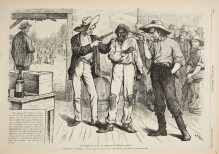 cartoon titled, “Of Course He Wants to Vote the Democratic Ticket” shows what the southern intimidation tactics looked like. The two white men are holding on to a black man and pointing guns at his head. The black man looks frightened. There is a crowd behind them smiling and watching on and it is clear that the man is about to vote. The text at the bottom says “Democratic ‘Reformer.’ ‘You’re as free as air, ain’t you? Say you are, or I’ll blow yer black head off!’” This quote shows that African Americans were not actually free at the time, especially in southern states. The quote “free as air” is making fun of a quote made by the parliamentary Waterson, who actually said that the “negroes of the South are free- free as air.” The voter intimidation that happened in the election of 1876 had a major impact on the results of the election and on the culture in the south.
cartoon titled, “Of Course He Wants to Vote the Democratic Ticket” shows what the southern intimidation tactics looked like. The two white men are holding on to a black man and pointing guns at his head. The black man looks frightened. There is a crowd behind them smiling and watching on and it is clear that the man is about to vote. The text at the bottom says “Democratic ‘Reformer.’ ‘You’re as free as air, ain’t you? Say you are, or I’ll blow yer black head off!’” This quote shows that African Americans were not actually free at the time, especially in southern states. The quote “free as air” is making fun of a quote made by the parliamentary Waterson, who actually said that the “negroes of the South are free- free as air.” The voter intimidation that happened in the election of 1876 had a major impact on the results of the election and on the culture in the south.
On Election Day, Samuel J. Tilden had the majority of the popular vote and had 184 of the 185 necessary for a majority of the Electoral College. Rutherford B. Hayes had about 166 electoral votes and the nineteen votes from the Republican controlled southern states, Florida, Louisiana, and South Carolina were in dispute. At the time, Congress was split with a Democratic House and a Republican Senate. Congress created a Federal Electoral Commission that had fifteen members of Congress and Supreme Court justices. In closed door meetings, the Democrats agreed to accept Hayes as president in return for Federal troops withdrawing from South Carolina and Louisiana. Had the Republicans not used rhetoric looking back on slavery and the Civil War, then perhaps Samuel J. Tilden could have received that one additional electoral vote to become the 19th President of the United States. And if southern Democrats would not have intimidated hundreds of black voters then perhaps the results would have been drastically different.
By Melissa Lucas–Marital Scandal and Presidential Elections
Monica Lewinsky recently published an article in Vanity Fair about her affair with Bill Clinton during his presidency. The article entitled “Shame and Survival” details how she negotiated the press spotlight and what she describes as “global humiliation” after her affair with Clinton became public. [1] Lewinsky wrote she hoped sharing her story would help those who are currently cyber bullied: “Perhaps by sharing my story, I reasoned, I might be able to help others in their darkest moments of humiliation. The question became: How do I find and give a purpose to my past?” [2] Many media outlets reported on Lewinsky’s essay in terms of how it will affect Hillary Clinton’s presumed 2016 presidential campaign. One editorial claimed Lewinsky’s story serves a reminder why “Hillary Clinton doesn’t deserve female voter support” and Bill Clinton should not be back in the White House. [3]
The policy stances and private lives of candidates are often blurred within presidential elections. Political commentators often argue that with the advent of the Internet, the private lives of presidential candidates are now under even closer scrutiny. Yet, it would be incorrect to assume the emphasis on candidates’ private lives is a recent occurrence. An examination of the 1828 presidential election between Andrew Jackson and John Quincy Adams demonstrates that the “private” lives of political candidates have always been a matter of public attention.
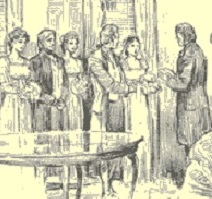 The details of Andrew Jackson’s marriage to Rachel Donelson caused controversy during the 1828 presidential election. Rachel Donelson married her first husband, Captain Lewis Robards, at 18 years old in 1785. By 1790, the two separated and Robards told Donelson he was filing for divorce. Andrew Jackson and Donelson married in 1791, believing the divorce was final. Two years later, the Jacksons learned Robards never filed for divorce and Rachel was married to two men. In 1794, Robards was granted a divorce on the grounds of adultery. The Jackson’s quietly remarried the same year after the divorce was finalized (left).
The details of Andrew Jackson’s marriage to Rachel Donelson caused controversy during the 1828 presidential election. Rachel Donelson married her first husband, Captain Lewis Robards, at 18 years old in 1785. By 1790, the two separated and Robards told Donelson he was filing for divorce. Andrew Jackson and Donelson married in 1791, believing the divorce was final. Two years later, the Jacksons learned Robards never filed for divorce and Rachel was married to two men. In 1794, Robards was granted a divorce on the grounds of adultery. The Jackson’s quietly remarried the same year after the divorce was finalized (left).
This scandal was in the foreground of the 1828 election between Andrew Jackson and John Quincy Adams. The press widely covered the story and Jackson’s opponents argued the scandal was evidence of “his unfitness for station to which he aspires.” [4] Charles Hammond, a critic of Andrew Jackson, wrote a campaign pamphlet entitled, “View of Jackson’s Domestic Relations: In Reference to His Fitness for the Presidency.” He argued that Mrs. Jackson’s past as a “bigamist and adulterer” made her unfit to be First Lady of the United States:
Whatever may be thought or said of other offices, every candid man must agree that the office of the President necessarily brings the immediate family of the officer, into direct connection with the public. . . If the President is a married man, his wife at least, must share the distinction of the station he occupies. [5]
The First Lady, according to Hammond, is a reflection of the nation’s character and if she is morally impure, then it reflects poorly on the entire nation. He wrote: “If her character be stained with suspicion it affects all around her, the community of which she is head” [6]. Jackson was also portrayed as a “seducer” of a married woman with little regard for moral standards. His lack of moral compass in his personal life, according to Adams supporters, demonstrated he was incapable of moral political leadership. Hammond asked the American public: “ought a convicted adulteress, and her paramour husband be placed in the highest offices of this free and Christian land?” [7]
 The American people answered yes. Andrew Jackson won the election with 178 electoral votes and almost 56% of the popular vote. Rachel Jackson (right) passed away before ever serving as First Lady. She died December 24, 1828, three months before Jackson’s inauguration. Part of her epitaph read, “A being so gentle and so virtuous slander might wound, but could not dishonor.” [8] The election of 1828 is just one of many in the history American presidential elections that spotlighted the “private life” scandals of nominees and spouses. This may lead us to ponder: Why do the “private” lives of our politicians and their significant others receive so much attention during presidential elections?
The American people answered yes. Andrew Jackson won the election with 178 electoral votes and almost 56% of the popular vote. Rachel Jackson (right) passed away before ever serving as First Lady. She died December 24, 1828, three months before Jackson’s inauguration. Part of her epitaph read, “A being so gentle and so virtuous slander might wound, but could not dishonor.” [8] The election of 1828 is just one of many in the history American presidential elections that spotlighted the “private life” scandals of nominees and spouses. This may lead us to ponder: Why do the “private” lives of our politicians and their significant others receive so much attention during presidential elections?
Notes:
[1] “Monica Lewinsky Writes About Her Affair with President Clinton,” Vanity Fair. http://www.vanityfair.com/online/daily/2014/05/monica-lewinsky-speaks
[2] Ibid.
[3] Linda Stasi. “Monica Lewinsky’s Story Reminds Us Bill Clinton is to blame, Hillary Clinton Doesn’t Deserve Female Voter Support,” New York Daily News, May 11, 2014, http://www.nydailynews.com/news/politics/stasi-monica-lewinsky-story-rings-true-article-1.1787850
[4] Charles Hammond. “View of General Jackson’s Domestic Relations in Reference to his Fitness for the Presidency,” Truth’s Advocate (1828): 1.
[5] Ibid., 2.
[6] Ibid., 12.
[7] Ibid., 3.
[8] “White House History First Ladies: Rachel Jackson,” The White House Historical Association, http://www.whitehousehistory.org/history/white-house-first-ladies/first-lady-rachel-jackson-emily-donelson.html
By Lauren Harris–‘Maverick, No More’: McCain’s Struggle to Rise above Bush’s Unpopular Legacy
The 2008 presidential election was an especially difficult time for the Republican Party. The party’s candidate, Arizona Senator John McCain, not only had to contend with his Democratic opponent but also with the public’s general disillusion with the George W. Bush presidency. The political cartoon, “Maverick No More,” epitomizes McCain’s struggle during the 2008 election. The cartoon was created by Pulitzer Prize winning editorial cartoonist Ben Sargent, who retired in 2009.
 George W. Bush was known somewhat as a southern cowboy, who lived on a large ranch in Texas when not at the White House. In the cartoon, Bush is seen branding a large “W” into a steer that has the face of McCain. In the corner of the cartoon is the title, “Maverick No More,” which refers to McCain’s nickname as “The Maverick.” This branding is symbolic for the significant impact the Bush administration had on the McCain campaign in 2008 and the difficulty McCain had with differentiating himself from the unpopular president.
George W. Bush was known somewhat as a southern cowboy, who lived on a large ranch in Texas when not at the White House. In the cartoon, Bush is seen branding a large “W” into a steer that has the face of McCain. In the corner of the cartoon is the title, “Maverick No More,” which refers to McCain’s nickname as “The Maverick.” This branding is symbolic for the significant impact the Bush administration had on the McCain campaign in 2008 and the difficulty McCain had with differentiating himself from the unpopular president.
Despite having the highest approval rating of any president after the 9/11 terrorist attacks, Bush left office in January 2009 with one of the lowest approval ratings in history (22%). After it came to light that the government presented evidence of Weapons of Mass Destruction (which ultimately led to the United States’ involvement in Iraq) as more concrete than it actually was, both conflicts in the Middle East, as well as the president, became increasingly unpopular with the American public. Also, the U.S. economy took a major hit leading up to the 2008 presidential election, which also contributed to Bush’s abysmal approval ratings. After two unpopular wars and a tanking economy, the American people were dissatisfied with the president and the Republican Party he represented.
McCain desperately needed to separate himself from the unpopular Bush administration. However, while McCain urged that he disapproved of Bush’s management of the Iraq war, news organizations reported that McCain and Bush remained very similar in their views about the economy and the continuation of the Iraq war. These issues were two of the most important in the 2008 election and McCain struggled to separate himself from Bush while still remaining loyal to his conservative ideals.
While McCain attempted to demonstrate to the American people that he was different from fellow Republican Bush, Obama incorporated this dissatisfaction into his campaign slogan.
 Despite McCain’s attempts to differentiate himself from Bush, Americans continued to see the Republicans as too similar for their liking. In June 2008, respondents to a USA Today/Gallup poll confirmed that McCain was in trouble: 49 percent of respondents claimed they were very concerned that McCain would pursue policies similar to the one’s Bush pursued and another 19 percent were somewhat concerned. Obama referred to these concerns often in his campaign discourse. McCain was dubbed “McBush,” past policies were referred to as “Bush-McCain policies” and Obama’s campaign often stated that a vote for McCain was a vote for a third Bush term. These statements reinforced the public’s fears that McCain and the very unpopular Bush were much more alike than the McCain team wanted to admit.
Despite McCain’s attempts to differentiate himself from Bush, Americans continued to see the Republicans as too similar for their liking. In June 2008, respondents to a USA Today/Gallup poll confirmed that McCain was in trouble: 49 percent of respondents claimed they were very concerned that McCain would pursue policies similar to the one’s Bush pursued and another 19 percent were somewhat concerned. Obama referred to these concerns often in his campaign discourse. McCain was dubbed “McBush,” past policies were referred to as “Bush-McCain policies” and Obama’s campaign often stated that a vote for McCain was a vote for a third Bush term. These statements reinforced the public’s fears that McCain and the very unpopular Bush were much more alike than the McCain team wanted to admit.
McCain countered these attacks by focusing on Obama’s lack of political experience, claiming that “the American people didn’t get to know me yesterday, as they are just getting to know Senator Obama.” However, America’s dissatisfaction with the Republican Party ran too deep. In November 2008, Americans voted for the candidate who ran on “change” rather than the Republican candidate that reminded them all too well of the preceding president.
Sources
CBSNews, “Bush’s Final Approval Rating: 22 Percent,” CBS, January 16, 2009, accessed May 15, 2014, http://www.cbsnews.com/news/bushs-final-approval-rating-22-percent/
James Gerber, “McCain: I’m Not Bush III,” ABC, June 3, 2008, accessed May 10, 2014, http://abcnews.go.com/blogs/politics/2008/06/mccain-im-not-b/
Jeffrey F. Jones, “Americans Worry McCain Would Be Too Similar to Bush,” USA Today/Gallup, July 1, 2008, accessed May 10, 2014, http://www.gallup.com/poll/108490/Americans-Worry-McCain-Would-Too-Similar-Bush.aspx
Barack Obama, “Remarks in Charleston, West Virginia: ‘The Cost of War,’” The White House, March 20, 2008, accessed May 10, 2014, http://www.presidency.ucsb.edu/ws/index.php?pid=76994
Michael Cooper, “McCain Distances Himself from Bush and Jabs Obama,” New York Times, June 4, 2008, accessed May 10, 2014, http://www.nytimes.com/2008/06/04/us/politics/04mccain.html?pagewanted=print
Photos
Freckles Cassie, “George W. Bush,” Political Teen Tidbits, March 09, 2008, accessed May 10, 2014, http://frecklescassie.wordpress.com/category/george-w-bush/
Oliver, “Troop Elections—From Oliver’s Blog,” Troop 90, September 30, 2008, accessed May 10, 2014, http://t90pacificgrove.blogspot.com/
